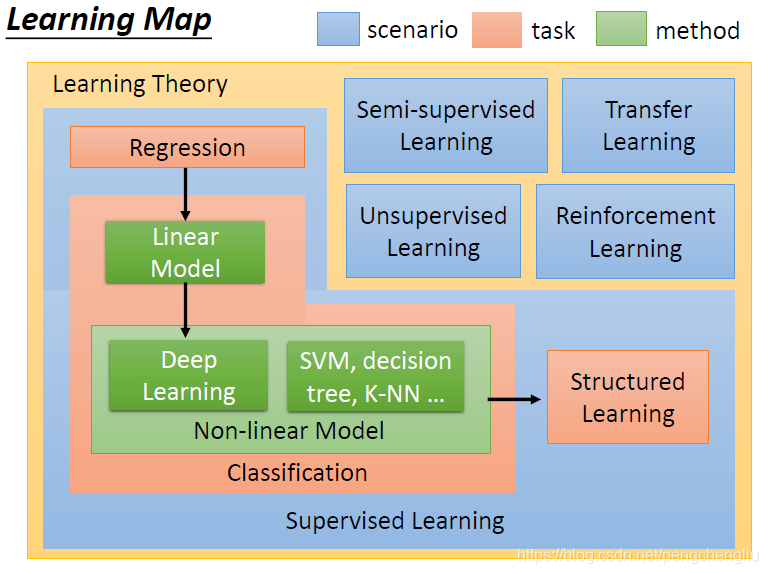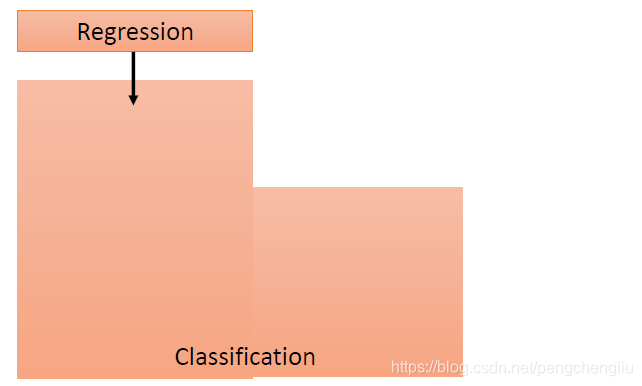| //李宏毅视频官网:http://speech.ee.ntu.edu.tw/~tlkagk/courses.html 点击此处返回总目录 //邱锡鹏《神经网络与深度学习》官网:https://nndl.github.io
------------------------------------------------------------------------------------------------------------------------------- 接下来我们要讲一下,在这门课里面,我们可以学到的和machine learning相关的技术。这个是这学期的learning map,看起来是有点复杂的。我们一块一块来解释。
------------------------------------------------------------------------------------------------------------------------------- 我们先从图的左上角开始。图的左上角是Regression。什么是Regression,Regression是一种machine learning的task。当我们要做Regression的时候,意思是说,我们的machine要找出来的function,它的输出是一个scalar,是一个数值,是一个real number。
举例来说,在作业1里面,我们会做PM2.5的预测。也就是说要找一个function,这个function的输出呢,是未来某一个时间,比如说明天上午的PM2.5。PM2.5是一个数值,是一个number,所以这是一个Regression的problem。当然这个machine要预测明天上午的PM2.5,他没有办法凭空猜出来嘛,显然要给他一些额外的信息。你给他的信息呢,可能是今天上午的PM2.5,明天上午的PM2.5等等。 那要训练这种machine,如之前machine learning的framework中讲的,要给他一些训练数据。什么样的训练数据,你就告诉他说,我们根据政府的open data 所收集的数据,9月1号上午的PM2.5为63,9月2号的为65,9月3号是这样子。一个好的function输入是9月1号和2号的PM2.5,应该输出9月3号的PM2.5;给他9月12号的,9月13号的,应该输出9月14号的。当收集够多的这种data,就可以做气象预报的系统。
------------------------------------------------------------------------------------------------------------------------------- 刚才讲的是Regression,接下来要将的是classification。
Regression和classification的差别就是,我们让机器输出的东西的类型是不一样的。在Regression里面,机器输出的是一个数值,在classification里面,机器输出的是个类别。 classification问题又分成两种:一种是binary classification,二元的分类;一种是Multi-class classification。在二元分类里面,我们要让机器输出的是是或否,yes或no。在multi-class classification里面,机器要做的事情是一个选择题,你等于是给他数个选项,每一个选项就是一个类别,它从所输的类别里面选择正确的类别。
|
Learning Map
最新推荐文章于 2022-09-06 16:41:41 发布








 本文将引导你创建自己的学习地图,这是一种强大的工具,用于组织和跟踪个人学习历程。通过定义目标、识别关键领域和子领域,以及确定学习资源,你可以构建一个有序的知识体系,从而更有效地学习和掌握新技能。
本文将引导你创建自己的学习地图,这是一种强大的工具,用于组织和跟踪个人学习历程。通过定义目标、识别关键领域和子领域,以及确定学习资源,你可以构建一个有序的知识体系,从而更有效地学习和掌握新技能。




 最低0.47元/天 解锁文章
最低0.47元/天 解锁文章
















 2万+
2万+

 被折叠的 条评论
为什么被折叠?
被折叠的 条评论
为什么被折叠?








